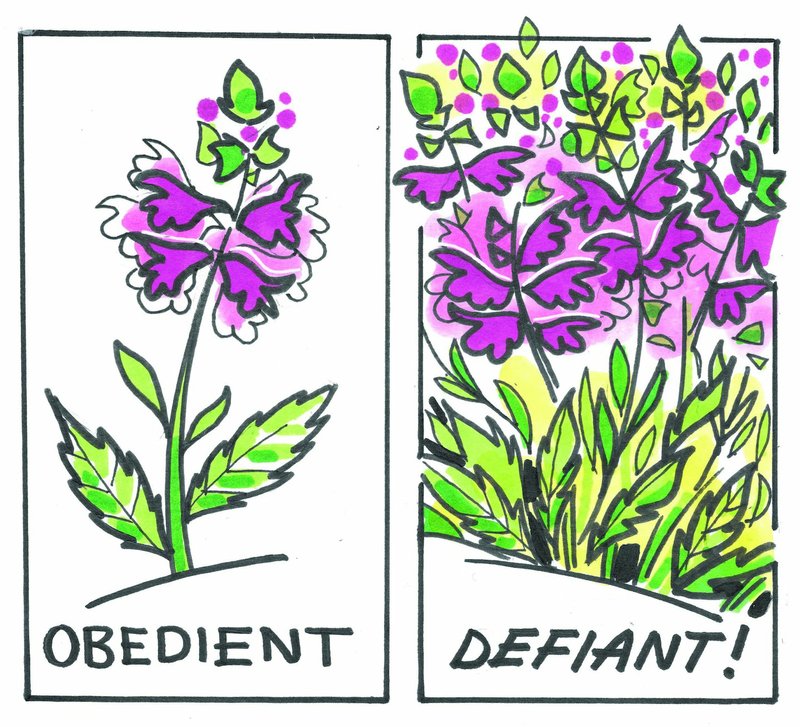Q I have a flowerbed that measures 25-by-15 feet. I added an obedient plant, and it took over the flowerbed in three years. There are many other perennials in this bed. I thought about solarization, but that would kill the other plants. Thought about removing daylilies and irises, also tiger lilies, etc. Very large project.
A Obedient plant is the common name for Physostegia, and a more incorrect name could not be found. This plant is anything but obedient — disobedient would be more in keeping with the plant. Give it an inch and it will take a mile. It spreads quite prolifically, as you have discovered. Solarization is one method that could work, but it is best done in the hot, summer months — June through early September. It uses the heat from the sun to basically cook the soil, but it would not target specific plants, it would get them all. Instead of such a broad-spectrum method, wait for the obedient plant to sprout and pull or hoe out as much as you can, then spot-spray with a glyphosate product, directing the spray just to the plants you want to kill. Any drift would also damage desirable plants. If the obedient plant is thick, over time it will out-compete some of your other perennials. You might select a few of your desirable plants that are special and dig and move those while you kill out the obedient plant. One weeding will not eradicate this plant, but with due diligence, you can get it under control.

Q I visited Garvan Gardens today and saw this plant [the reader sent a photo]. It was near the camellias. Can you tell me what it is? I'd love to add it to my landscape.
A The plant in question is a hellebore, a great shade-loving perennial. Depending on variety, they can bloom from late November through mid-April. Flower colors range through shades of reds, whites, purples and bi-colors. There are single- and double-flowered forms. The plants are evergreen but are basically semi-dormant during the summer. They do their growing from fall through spring and rest in the summer, not adding any additional leaves then. They are poisonous, so deer leave them alone. It is one of my favorite perennials.
Q Weeds of some type are popping up in my lawn, is there anything I can do at this time to stop them?
A Winter weeds are beginning to grow nicely, and I have seen blooms on dandelions, chickweed and henbit. If you want a weed-free yard, you need to move fairly quickly and use a broadleaf herbicide. There are numerous brands with a three-way mix such as Trimec, 3 in 1 Weed Control, etc. Make sure you read the label to ensure it is safe to apply to the lawn grass you are growing. Pay attention to weather conditions and avoid spraying on a windy or extremely cold day. The key is to get to them before they are too large or have already set seeds for next year.
Q I have been following your In the Garden with Janet Carson blog for years as a subscriber. I have enjoyed following along on your trips, watching what is growing in the garden and learning about what is happening in our state. I know that you retired at the beginning of the year, and were leaving the blog with the extension service, but I miss you. I thought you said you were going to start a new blog. If you have, I don't know about it. I know it is probably time-consuming and you may have better things to do now that you are retired, but I for one would love to see what you are up to. Please know that I am so happy that you are still writing columns. That would have been too big a blow if you had stopped writing them as well. Thanks for all you do and have done for gardeners in our state. One day I want to become a Master Gardener too — when I retire.
A Thank you for the kind words. I have enjoyed writing the blog as well, so I did start a new blog — Planit Janet, housed on the Arkansas Democrat-Gazette's website. It is a different format from the WordPress blog I did when I worked for the University of Arkansas Cooperative Extension Service. With the WordPress blog you could subscribe to receive via email a copy of any blog post that I wrote. That blog is ongoing but now called In the Garden With Arkansas Extension Horticulture — but not written by me — and if you subscribed, you should still be receiving it.
You can sign up for my new Planit Janet blog, and you don't have to be a newspaper subscriber to do so. You go to arkansasonline.com/planitjanet. The top article "About: Planit Janet Blog" has a link to sign up, or you can click "Follow."
I am sharing the blog posts on Facebook, so if you do Facebook they will appear there. If you sign up to follow Planit Janet, you will receive a newsletter every Monday via email with the blog posts for the week. It will also include a link to my Q&A column plus my feature stories, but to read those in their entirety, you do have to be a newspaper subscriber.
Retired after 38 years with the University of Arkansas Cooperative Extension Service, Janet Carson ranks among Arkansas' best known horticulture experts. Write to her at P.O. Box 2221, Little Rock, AR 72201 or email
jcarson@arkansasonline.com
HomeStyle on 02/23/2019
